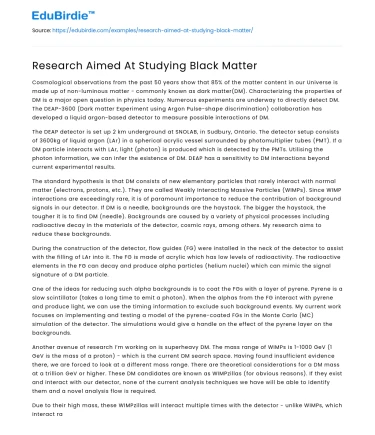Cosmological observations from the past 50 years show that 85% of the matter content in our Universe is made up of non-luminous matter - commonly known as dark matter(DM). Characterizing the properties of DM is a major open question in physics today. Numerous experiments are underway to directly detect DM. The DEAP-3600 (Dark matter Experiment using Argon Pulse-shape discrimination) collaboration has developed a liquid argon-based detector to measure possible interactions of DM.
The DEAP detector is set up 2 km underground at SNOLAB, in Sudbury, Ontario. The detector setup consists of 3600kg of liquid argon (LAr) in a spherical acrylic vessel surrounded by photomultiplier tubes (PMT). If a DM particle interacts with LAr, light (photon) is produced which is detected by the PMTs. Utilising the photon information, we can infer the existence of DM. DEAP has a sensitivity to DM interactions beyond current experimental results.
Save your time!
We can take care of your essay
- Proper editing and formatting
- Free revision, title page, and bibliography
- Flexible prices and money-back guarantee
The standard hypothesis is that DM consists of new elementary particles that rarely interact with normal matter (electrons, protons, etc.). They are called Weakly Interacting Massive Particles (WIMPs). Since WIMP interactions are exceedingly rare, it is of paramount importance to reduce the contribution of background signals in our detector. If DM is a needle, backgrounds are the haystack. The bigger the haystack, the tougher it is to find DM (needle). Backgrounds are caused by a variety of physical processes including radioactive decay in the materials of the detector, cosmic rays, among others. My research aims to reduce these backgrounds.
During the construction of the detector, flow guides (FG) were installed in the neck of the detector to assist with the filling of LAr into it. The FG is made of acrylic which has low levels of radioactivity. The radioactive elements in the FG can decay and produce alpha particles (helium nuclei) which can mimic the signal signature of a DM particle.
One of the ideas for reducing such alpha backgrounds is to coat the FGs with a layer of pyrene. Pyrene is a slow scintillator (takes a long time to emit a photon). When the alphas from the FG interact with pyrene and produce light, we can use the timing information to exclude such background events. My current work focuses on implementing and testing a model of the pyrene-coated FGs in the Monte Carlo (MC) simulation of the detector. The simulations would give a handle on the effect of the pyrene layer on the backgrounds.
Another avenue of research I’m working on is superheavy DM. The mass range of WIMPs is 1-1000 GeV (1 GeV is the mass of a proton) - which is the current DM search space. Having found insufficient evidence there, we are forced to look at a different mass range. There are theoretical considerations for a DM mass at a trillion GeV or higher. These DM candidates are known as WIMPzillas (for obvious reasons). If they exist and interact with our detector, none of the current analysis techniques we have will be able to identify them and a novel analysis flow is required.
Due to their high mass, these WIMPzillas will interact multiple times with the detector - unlike WIMPs, which interact rarely. They can also be referred to as Multiply Interacting Massive Particles - MIMPs. We are building a MC simulation for these MIMPs which looks at the response of the detector to them and establishes techniques for searching for them in data. This analysis would put stronger constraints on the existence of DM in that (higher) mass regime.
With many DEAP researchers located here, Carleton University is an ideal location for this research. Additionally, the physics department at Carleton comprises several theoretical and experimental particle physicists which helps provide a conducive environment for research in experimental astroparticle physics. Apart from Carleton support, there is a collaboration with researchers at INFN, Italy for the MIMP analysis. With this strong collaborative framework, there is a wealth of support for successfully completing my PhD and contribute to the solution of the fundamental question - “What is the Universe made of?”






 Stuck on your essay?
Stuck on your essay?

